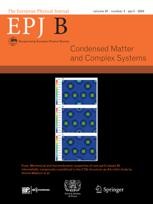Skyrmion dynamics and traverse mobility
Skyrmions could revolutionise computing exhibiting great potential in the electronic storage of information, and the key to such a breakthrough could be understanding their behaviour under applied currents.
New York | Heidelberg, 19 June 2020
 As the demands on information technology increase, the need to improve the storage of data also grows. Many solid-state systems suggested for such a task are founded on the manipulation of skyrmions, perfect for such a role due to their size and stability. In a study published in EPJ B, authors N.P. Vizarim and C.J.O. Reichhardt from the Theoretical Division and Center for Nonlinear Studies, Los Alamos National Laboratory, New Mexico, USA and their colleagues aim to understand how skyrmions behave in a substrate under dc and ac drives.
As the demands on information technology increase, the need to improve the storage of data also grows. Many solid-state systems suggested for such a task are founded on the manipulation of skyrmions, perfect for such a role due to their size and stability. In a study published in EPJ B, authors N.P. Vizarim and C.J.O. Reichhardt from the Theoretical Division and Center for Nonlinear Studies, Los Alamos National Laboratory, New Mexico, USA and their colleagues aim to understand how skyrmions behave in a substrate under dc and ac drives.
Skyrmions, nanoscale quasiparticles made up of knotted interlocking magnetic field lines moving through a material, are difficult to understand beyond pure mathematical descriptions.
Thus, to conduct their study the team mathematically modelled a two-dimensional system of size L × L with periodic boundary conditions in the x and y-axis. Throughout this model, they placed a lattice of obstacles for the skyrmion to traverse.
Initially, the skyrmion was only placed under the influence of a dc drive revealing directional locking effects that depended on the scale of the obstacles and whether the pinning mechanism used to hold the quasiparticle in 2D was repulsive or attractive.
A biharmonic ac drive was then applied to the system, generating a circular motion in the skyrmion. The researchers also discovered that by varying ac drive frequencies, a skyrmion’s transverse mobility can be enhanced.
One element the team’s study did not consider was the effect of temperature on the skyrmion system. Thermal variations can ‘wash out’ locking effects, hence why skyrmions are closely associated with Bose-Einstein condensates — a state of matter found at the edge of absolute zero.
Interestingly, in addition to its place in the development of future computing, skyrmion research may also solve the long-standing mystery of ‘ball lightning’ providing an example of how fundamental these strange, almost abstract mathematical quirks are to the material world.
References: N.P. Vizarim, C.J.O. Reichhardt, P.A. Venegas, and C. Reichhardt (2020), Skyrmion Dynamics and Transverse Mobility: Skyrmion Hall Angle Reversal on 2D Periodic Substrates with dc and Biharmonic ac Drives, European Physical Journal B 93:112, DOI: 10.1140/epjb/e2020-10135-1
Further Information
For more information visit: www.epj.org
Services for Journalists
The full-text article is available here.
Contact
Sabine Lehr | Springer | Physics Editorial Department
tel +49-6221-487-8336 | sabine.lehr@springer.com
